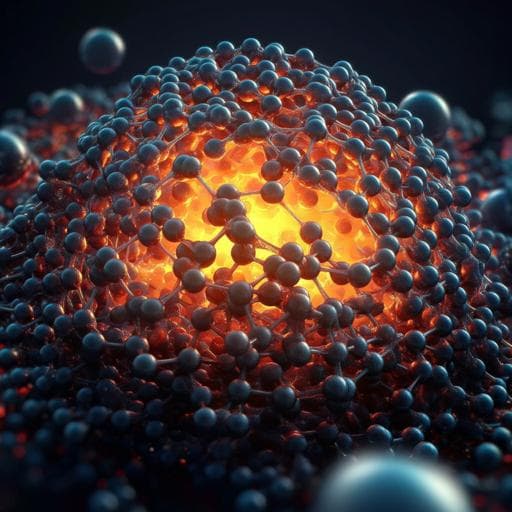
Engineering and Technology
An accurate and transferable machine learning interatomic potential for nickel
X. Gong, Z. Li, et al.
This groundbreaking research by Xiaoguo Gong, Zhuoyuan Li, A. S. L. Subrahmanyam Pattamatta, Tongqi Wen, and David J. Srolovitz unveils a magnetism-hidden Deep Potential model for nickel, offering precise predictions of essential material properties crucial for advancing applications in engineering and technology.
~3 min • Beginner • English
Introduction
Deformation mechanisms and mechanical properties are central to metallic materials. At coarse grain sizes, strength and hardness generally follow the Hall–Petch relationship; at nanometer grain sizes they often exhibit inverse Hall–Petch behavior with deformation dominated by stacking faults or twins. Allotropic phase transformations can strongly influence mechanical response (e.g., transformation-induced plasticity) under high stresses, particularly in nanostructured systems. Nickel (Ni), an FCC metal with high stacking fault energy, primarily deforms via partial dislocation motion and/or twinning. Under high shear rates or in very fine grains (< ~17 nm), FCC Ni can transform to HCP; such HCP-in-FCC microstructures show high hardness and yield strength. HCP Ni also appears in thin hetero-epitaxial films. The thermodynamics of FCC ↔ HCP in Ni remains unclear, necessitating atomistic simulations that accurately reproduce both stable and metastable thermodynamics and mechanical response across phases.
DFT offers high-fidelity, quantum-mechanical accuracy but is computationally prohibitive for large systems and long times, especially when spin polarization (important below Curie temperature ~627 K) is included. Even non-magnetic properties in Ni depend sensitively on spin degrees of freedom: elastic moduli, vacancy and interstitial formation energies, stacking fault energies, and mechanical properties differ markedly between spin-polarized and non-spin DFT; e.g., non-spin DFT elastic constants can err by ~23% relative to experiment, whereas spin-polarized DFT agrees much better.
Empirical/semi-empirical interatomic potentials (EAM/MEAM) are widely used but limited by fixed functional forms and lack of transferability, particularly for non-equilibrium structures like HCP Ni. Benchmarking many EAM/MEAM potentials reveals large discrepancies for basic HCP properties (e.g., elastic constants deviate by up to ~41%), undermining predictions of deformation and phase transitions.
Machine-learning (ML) interatomic potentials can, in principle, combine accuracy and efficiency, but capturing magnetic effects is challenging. Training on spin-polarized DFT data is a straightforward path, though prior GAP/NNP efforts often showed limited transferability across diverse properties. Here, the authors develop a 'magnetism-hidden' DP model trained on spin-polarized DFT energies/forces/virials without explicitly including magnetic moments as descriptors, and demonstrate robust, transferable accuracy for FCC and HCP Ni across finite-temperature properties, defects, and phase transformations.
Literature Review
The paper surveys limitations of classical potentials for Ni: multiple EAM and MEAM models, despite successes in some areas, show poor transferability to non-equilibrium structures (e.g., metastable HCP), with large deviations in elastic constants (up to ~41% in C13, C33, C44). These inaccuracies hinder reliable predictions of mechanical behavior and phase transitions. ML potentials that ignore magnetism lead to unreliable predictions for key properties. Prior work incorporating spin-polarized DFT training in GAP and neural network potentials demonstrated progress but frequently lacked sufficient transferability and representation across diverse properties (elasticity, defects, finite-temperature behavior). The Deep Potential (DP) method has been successful broadly but rarely employs spin-polarized datasets. The authors position their approach within this context: using spin-polarized DFT data to implicitly encode magnetic effects into a simple NNP architecture (DeepPot-SE) to achieve robust prediction of non-magnetic properties for both FCC and HCP Ni, including defects and phase transformations, outperforming widely used EAM/MEAM and an ML qSNAP potential in breadth and accuracy.
Methodology
Model development and training:
- Framework: Deep Potential (DeepPot-SE) trained via DP-GEN concurrent learning. A 'specialization' strategy augments general training data with targeted configurations along the cohesive energy curve.
- Initial dataset: Distorted 2×2×2 BCC, FCC, HCP supercells (volumes scaled 0.96–1.06; random perturbations) subjected to 100 K AIMD (NVT) to yield 108 spin-polarized DFT-labeled configurations (coordinates, energies, forces, virials).
- DP-GEN loop: Exploration via DPMD on bulk and surfaces across temperatures 50–3283.2 K (≈1.9× Tmelt) and pressures 0.001–50 kbar. Surfaces: {100}, {110}, {111} for BCC/FCC; (0001), {10-10} for HCP. Selected configurations (based on model disagreement criterion) are evaluated with spin-polarized DFT and added to the training set. Convergence when DP and DFT forces agree within a threshold.
- Specialization: To correct residual discrepancies in cohesive energy curves, 170 configurations along the cohesive line (17 structures, each weighted ×10) were generated and merged with DP-GEN data. Final training set: 2020 spin-polarized DFT entries.
- Network and training details: DeepPot-SE with 6 Å cutoff, neural network 240×240×240. Four models initialized with different random seeds; 400,000 epochs per training; learning rate decays from 1e-3 to 5e-6. Loss prefactors for energy, forces, and virials varied during training per DP-GEN protocol.
First-principles calculations (labels and benchmarks):
- Code and setup: VASP with PAW method; PBE-GGA exchange–correlation; Ni 3d8 4s2 valence. Plane-wave cutoff 600 eV; Methfessel–Paxton smearing 0.12 eV; Monkhorst–Pack k-point spacing ~0.1 Å⁻1. Convergence: total energy 10 eV/atom and ionic forces 1e-2 eV/Å. All ground-state and AIMD data spin-polarized.
Molecular dynamics/statics for property evaluation:
- Code: LAMMPS. Structure optimization via conjugate gradient (force tolerance 1e-10 eV/Å; self-interstitial studies converged in energy to 1e-6). Identical supercell sizes/configurations used across DFT and MD for elastic constants, surfaces, point defects, GBs, stacking faults (GSFE), cohesive/decohesive energies, phonons, and ideal strength.
- Finite-temperature properties: Lattice parameter and elastic constants from MD across 0–1728 K; melting point via two-phase method.
- Dislocations: Edge and screw (b = a/2[110]) inserted in large supercells (edge: 301×17×85 ų, line ‖ y; screw: 15×302×85 ų, line ‖ x) with periodicity along line and Burgers vector directions; relaxed at 0 K. Analysis via OVITO, CNA, DXA, and differential displacement plots.
- Grain boundaries: Constructed high-angle symmetric tilt GBs; systematic rigid-body translations and relaxation to find minimum-energy structures; energies compared with DFT.
- GSFE: γ-lines along {111}<110>/2 and {111}<112>/2; γ-surface mapping to identify stable/unstable stacking faults and dissociation pathways.
Benchmarking:
- Compared DP-Ni against DFT, experiment, and selected potentials: EAM (Mishin), MEAM_2021 (Vita), MEAM_2015 (Ko), and ML qSNAP (Zuo).
Key Findings
General accuracy and transferability:
- Energetics and structures: For FCC and HCP, DP-Ni energies within ~3 meV/atom of DFT; lattice parameters within ~0.004 Å of DFT/experiment. Cohesive energy for FCC matches DFT; slight deviation from experiment likely due to DFT reference. HCP cohesive energy closely matches DFT.
- Elastic constants: FCC Ni deviations relative to DFT/experiment small (largest ~6.8% for C11 and ~2.3% for C44). HCP Ni elastic constants accurately reproduced and satisfy Born criteria; maximum deviation ~9.6% (C12). Competing potentials show large HCP deviations (e.g., EAM C13 37.4%, C33 35.5%, C44 15.9%; MEAMs and qSNAP C44 ~31–39%).
- Phonons: DP-Ni reproduces measured FCC phonon spectra (298 K neutron data) and DFT HCP spectra without imaginary modes; other potentials show notable deviations at symmetry points.
Surfaces and point defects (FCC):
- Unrelaxed surface energies: Ordering {111} lowest, (210) highest reproduced; DP-Ni max error ~2.2% [(221)]. EAM and MEAM_2015 generally underestimate by ~6–16%.
- Vacancy formation energy: DFT 1.424 eV; DP-Ni 1.236 eV (−13.2% vs DFT) yet within experimental range (1.4–1.8 eV for other potentials).
- Self-interstitials: DFT ordering: (100) dumbbell < octahedral < (111) dumbbell < tetrahedral ≈ crowdion ≈ (110) dumbbell; DP-Ni captures all metastable configurations with max deviation < ~6.8% (tetrahedral), though ordering slightly differs. Training contained no vacancy/interstitial data, indicating strong transferability.
Cohesive/decohesive energetics and ideal strength:
- Cohesive energy curve (0 K): DP-Ni overlaps DFT smoothly from 0.5 a0 to 2.5 a0; several other potentials show discontinuities or large deviations.
- Decohesion (uniaxial separation) energies and stresses for {100}, {110}, {111}, {112}: DP-Ni closely matches DFT across separation distances; EAM shows discontinuities and unphysical stress oscillations; MEAM_2015 exhibits abrupt jumps near d ~ 2.5 Å; qSNAP peak stress shifted by ~1 Å for some planes.
- Ideal strengths from stress–strain: DFT baselines include hydrostatic σ_ideal ≈ 29.0 GPa at ε ≈ 0.52; [001] tension σ_ideal ≈ 35.3 GPa at ε ≈ 0.41; (111)[112] shear σ_ideal ≈ 15.9 GPa at γ ≈ 0.28, with strong anisotropy. DP-Ni reproduces curves and σ_ideal values well; largest deviation ≈10.4% ([011] tension) and 9.3% ((111)[112] shear) in nonlinear regions. Several competing potentials over/underestimate σ_ideal and/or strains.
Finite-temperature properties (FCC):
- Lattice parameter vs T (0–1728 K): DP-Ni agrees well with experiment above ~600 K; thermal expansion slope comparable to experiment.
- Elastic constants C11, C12, C44 vs T: DP-Ni shows monotonic decrease consistent with DFT (QHA) and experiments; other potentials display abnormal trends (e.g., EAM increasing Cij at low T; MEAM_2021 and qSNAP anomalies in C12) or >15% magnitude discrepancies at higher T (e.g., MEAM_2015 C12 for T > 700 K).
- Melting point: DP-Ni Tm = 1635 ± 5 K (two-phase method), ~5.4% below experimental 1728 K; MEAM_2015 ~9.5% above experiment.
Stacking faults, dislocations, and GSFE (FCC):
- GSFE γ-lines on {111}: DFT γ_usf ≈ 766.6 mJ/m² for <110>/2; along <112>/2, DFT γ_usf ≈ 280.4 mJ/m² and γ_sf ≈ 135.9 mJ/m² (near experimental ~125 mJ/m²). DP-Ni reproduces γ_usf within ~4.6% (<110>/2), and along <112>/2 reproduces γ_usf within ~7.6% and γ_sf within ~6.7%. Some competing potentials underestimate γ_sf (MEAM_2021 yields unphysical negative γ_sf), or overestimate γ_usf (EAM), or fail to capture minima (MEAM_2015). Training contained no stacking fault data.
- Dislocation dissociation: DP-Ni predicts Shockley partial separation distances dedge ≈ 19.25 Å (consistent with WB-TEM 26 ± 8 Å) and dscrew ≈ 11.83 Å (close to prior DFT ~12.0 Å).
Grain boundaries:
- High-angle symmetric tilt GBs: DP-Ni reproduces DFT GB energies within < ~6.7%, with correct energy ordering (Σ3[110](111) lowest). Other potentials misestimate magnitudes and, in some cases, produce unphysical results (e.g., MEAM_2021 negative energy for Σ3[110](111)).
Allotropic transformation under uniaxial tension:
- Under [001] tension at 0 K, stress increases then drops abruptly at ε ≈ 0.226, signaling FCC → HCP transformation. The HCP phase remains stable for at least an additional ~15% strain. DFT-computed stresses on DP configurations match DP-Ni closely, and cumulative energy differences at the transformation point are ΔE_DP ≈ 0.209 eV/atom and ΔE_DFT ≈ 0.221 eV/atom (~10 meV/atom difference). An atypical orientation relation is found: {100}FCC || {0001}HCP and (010)FCC || (11-20)HCP, associated with large strains, differing from the commonly reported {111}FCC || {0001}HCP, (110)FCC || (11-20)HCP.
Discussion
The study addresses the central challenge of simulating mechanical behavior and phase transformations in magnetic metals like Ni at scale, where magnetism significantly influences non-magnetic properties but explicit spin degrees of freedom are computationally prohibitive in large-scale simulations. By training a Deep Potential model on spin-polarized DFT data while omitting explicit magnetic descriptors, the authors embed magnetic effects implicitly into the potential energy surface. This 'magnetism-hidden' strategy yields a potential (DP-Ni) that reproduces DFT-level accuracy across phases (FCC and HCP), temperatures, and defect configurations not explicitly included in training (vacancies, interstitials, stacking faults), demonstrating strong transferability.
Comprehensive benchmarks show DP-Ni matching or surpassing widely used EAM/MEAM and a state-of-the-art ML potential (qSNAP) in elastic properties, phonons, surfaces, point defects, GSFE, dislocation core splitting, GB energies, cohesive/decohesive behavior, and ideal strengths. Critically, DP-Ni accurately captures finite-temperature trends and an allotropic FCC → HCP transformation under uniaxial loading, including stress–strain response, transformation strain, and an atypical orientation relationship. These results validate the approach as a reliable tool for large-scale simulations of deformation and phase transformation in Ni. The findings suggest that carefully curated, spin-polarized DFT training data combined with targeted specialization can produce simple, robust NNPs for magnetic structural materials without explicit magnetic degrees of freedom, providing a path to accurate simulations of complex microstructural phenomena and enabling studies of Ni-based superalloys and multi-principal element alloys.
Conclusion
The authors developed a spin-polarized DFT-trained, 'magnetism-hidden' Deep Potential for Ni (DP-Ni) that achieves DFT-level accuracy for a broad suite of properties in both stable FCC and metastable HCP phases: lattice parameters, elastic constants (including temperature dependence), phonon spectra, cohesive and decohesive energetics/stresses, point defects, stacking faults and GSFE, dislocation dissociation, and grain boundary structures/energies. DP-Ni also accurately captures ideal strength anisotropy and an FCC → HCP phase transformation under [001] tension, including the critical strain and an atypical orientation relationship, while maintaining close agreement with DFT stresses and energies. Compared to leading EAM/MEAM and ML potentials, DP-Ni exhibits superior transferability and quantitative fidelity across equilibrium and non-equilibrium configurations.
Future research directions include: (i) extending the approach to Ni-based superalloys and medium-/high-entropy alloys (e.g., FeCoNi systems) using DP attention pretraining; (ii) enriching training datasets with additional finite-temperature and interfacial (solid–liquid) configurations to refine melting and transport properties; (iii) exploring explicit spin or magnetic state descriptors where magnetic responses themselves are of interest; and (iv) applying the workflow to other magnetic structural metals and alloys undergoing complex phase transformations.
Limitations
- Reference fidelity: Some discrepancies relative to experiment likely originate from the underlying DFT (PBE) reference and quasi-harmonic approximations used for finite-temperature properties.
- Melting behavior: The predicted melting point (1635 ± 5 K) is ~5.4% below the experimental 1728 K, potentially reflecting limited training on solid–liquid interfacial configurations and/or DFT limitations.
- Training coverage: While transferability is strong, training did not explicitly include vacancies, self-interstitials, stacking faults, or plane separation data; minor deviations (e.g., vacancy formation energy ~13% below DFT; slight reordering of interstitial energies) indicate possible areas for targeted refinement.
- Magnetism treatment: Magnetic effects are learned implicitly from spin-polarized DFT labels; explicit prediction of magnetic properties or behavior across magnetic phase transitions is beyond the present model’s scope.
Related Publications
Explore these studies to deepen your understanding of the subject.







